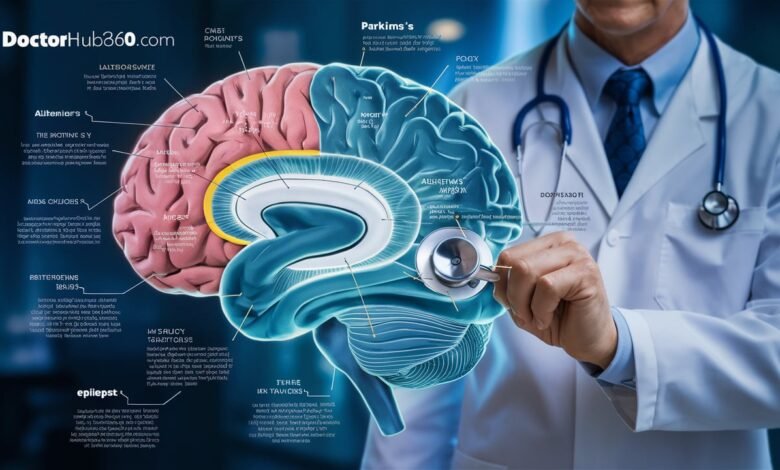Doctorhub360.com Neurological Diseases

Neurological diseases represent a vast and intricate category of medical conditions affecting the central and peripheral nervous systems. These disorders, which encompass a wide range of ailments from common headaches to debilitating neurodegenerative diseases, can disrupt virtually every aspect of human life, impacting movement, cognition, sensation, and overall well-being. Understanding the complexities of neurological diseases, including their diverse types, underlying causes, diagnostic methods, and treatment options, is crucial for both healthcare professionals and individuals seeking to navigate the challenges these conditions present.
I. Understanding the Nervous System: The Foundation of Neurological Health
To grasp the intricacies of neurological diseases, it’s essential to have a foundational understanding of the nervous system, the intricate network responsible for coordinating and controlling the body’s functions. The nervous system is broadly divided into two main components:
- Central Nervous System (CNS): The CNS acts as the body’s control center, comprising the brain and spinal cord. The brain, a complex organ with billions of neurons, is responsible for higher-level functions like thought, memory, emotion, and voluntary movement. The spinal cord serves as a communication pathway between the brain and the rest of the body, transmitting sensory information and motor commands.
- Peripheral Nervous System (PNS): The PNS encompasses all the nerves that extend outside the CNS, connecting the brain and spinal cord to the rest of the body. It is further divided into the somatic nervous system, which controls voluntary movements, and the autonomic nervous system, which regulates involuntary functions like heart rate, digestion, and breathing.
II. Categorizing Neurological Diseases: A Diverse Spectrum of Conditions
Neurological diseases encompass a diverse spectrum of conditions, each with its unique characteristics and impact on the nervous system. These disorders can be broadly categorized based on various factors, including the primary location affected, the type of dysfunction involved, and the underlying cause:
A. By Location: Targeting Specific Parts of the Nervous System
- Brain Disorders: These conditions affect the brain’s structure, function, or both, leading to a wide range of cognitive, motor, and sensory impairments. Examples include:
- Stroke: This occurs when the blood supply to the brain is interrupted, causing brain cells to die.
- Brain Tumors: Abnormal growths in the brain that can disrupt normal brain function.
- Alzheimer’s Disease: A progressive neurodegenerative disease that impairs memory, thinking, and behavior.
- Parkinson’s Disease: A progressive movement disorder caused by the loss of dopamine-producing neurons in the brain.
- Epilepsy: A neurological disorder characterized by recurrent seizures due to abnormal electrical activity in the brain.
- Spinal Cord Disorders: These conditions affect the spinal cord, disrupting the flow of information between the brain and the body. Examples include:
- Spinal Cord Injury: Damage to the spinal cord caused by trauma, leading to loss of motor and sensory function.
- Multiple Sclerosis (MS): An autoimmune disease that attacks the protective myelin sheath around nerve fibers in the brain and spinal cord.
- Peripheral Nerve Disorders: These conditions affect the peripheral nerves, disrupting communication between the brain and the rest of the body. Examples include:
- Peripheral Neuropathy: Damage to the peripheral nerves, causing pain, numbness, and weakness in the hands and feet.
- Guillain-Barré Syndrome: An autoimmune disorder that attacks the peripheral nerves, leading to muscle weakness and paralysis.
B. By Dysfunction: Targeting Specific Neurological Processes
- Movement Disorders: These conditions affect the ability to control movement, leading to tremors, stiffness, slowness, and other motor impairments. Examples include:
- Parkinson’s Disease: As mentioned earlier, this is a progressive movement disorder characterized by tremors, rigidity, bradykinesia (slowness of movement), and postural instability.
- Essential Tremor: A common neurological disorder that causes involuntary shaking, often in the hands.
- Huntington’s Disease: A genetic disorder that causes progressive degeneration of nerve cells in the brain, leading to movement, cognitive, and psychiatric problems.
- Cognitive Disorders: These conditions affect cognitive functions such as memory, thinking, language, and judgment. Examples include:
- Alzheimer’s Disease: The most common cause of dementia, characterized by progressive memory loss and cognitive decline.
- Vascular Dementia: Cognitive impairment caused by reduced blood flow to the brain.
- Frontotemporal Dementia: A group of disorders that affect the frontal and temporal lobes of the brain, leading to changes in personality, behavior, and language.
- Seizure Disorders: These conditions are characterized by recurrent seizures, which are caused by abnormal electrical activity in the brain. Examples include:
- Epilepsy: As mentioned earlier, this is a common neurological disorder characterized by recurrent seizures.
- Pain Disorders: These conditions cause chronic pain, which can be debilitating and significantly impact quality of life. Examples include:
- Migraine: A type of headache that can cause severe throbbing pain or a pulsing sensation, usually on one side of the head.
- Trigeminal Neuralgia: A chronic pain condition that affects the trigeminal nerve, which carries sensation from the face to the brain.
C. By Cause: Unraveling the Origins of Neurological Diseases
- Genetic Disorders: These conditions are caused by inherited genetic mutations that disrupt the development or function of the nervous system. Examples include:
- Huntington’s Disease: As mentioned earlier, this is a genetic disorder caused by a mutation in the Huntingtin gene.
- Muscular Dystrophy: A group of genetic disorders that cause progressive muscle weakness and degeneration.
- Infectious Diseases: These conditions are caused by infections that affect the nervous system. Examples include:
- Meningitis: Inflammation of the membranes surrounding the brain and spinal cord, usually caused by a bacterial or viral infection.
- Encephalitis: Inflammation of the brain, usually caused by a viral infection.
- Autoimmune Disorders: These conditions are caused by the immune system attacking the nervous system. Examples include:
- Multiple Sclerosis (MS): As mentioned earlier, this is an autoimmune disease that attacks the myelin sheath around nerve fibers in the brain and spinal cord.
- Guillain-Barré Syndrome: As mentioned earlier, this is an autoimmune disorder that attacks the peripheral nerves.
- Traumatic Injuries: These conditions are caused by physical trauma to the brain or spinal cord. Examples include:
- Traumatic Brain Injury (TBI): Damage to the brain caused by a blow or jolt to the head.
- Spinal Cord Injury: As mentioned earlier, this is damage to the spinal cord caused by trauma.
- Vascular Disorders: These conditions are caused by problems with blood supply to the brain or spinal cord. Examples include:
- Stroke: As mentioned earlier, this occurs when the blood supply to the brain is interrupted.
- Vascular Dementia: As mentioned earlier, this is a cognitive impairment caused by reduced blood flow to the brain.
III. Diagnostic Approaches: Unveiling the Nature of Neurological Diseases
Diagnosing neurological diseases often requires a comprehensive approach that involves a thorough medical history, neurological examination, and various diagnostic tests.
- Medical History and Neurological Examination: The doctor will ask about the patient’s symptoms, medical history, and family history. A neurological examination is performed to assess the patient’s mental status, cranial nerve function, motor function, sensory function, reflexes, and coordination.
- Neuroimaging Techniques: These techniques provide detailed images of the brain and spinal cord, helping to identify structural abnormalities, tumors, and other abnormalities. Common neuroimaging techniques include:
- Magnetic Resonance Imaging (MRI): Uses magnetic fields and radio waves to create detailed images of the brain and spinal cord.
- Computed Tomography (CT) Scan: Uses X-rays to create cross-sectional images of the brain and spinal cord.
- Electrodiagnostic Tests: These tests measure the electrical activity of the brain and nerves, helping to diagnose conditions such as epilepsy and peripheral neuropathy. Common electrodiagnostic tests include:
- Electroencephalogram (EEG): Measures the electrical activity of the brain using electrodes placed on the scalp.
- Electromyography (EMG): Measures the electrical activity of muscles using electrodes inserted into the muscles.
- Nerve Conduction Studies (NCS): Measure the speed and strength of electrical signals traveling through nerves.
- Lumbar Puncture (Spinal Tap): This procedure involves inserting a needle into the lower back to collect cerebrospinal fluid (CSF), which surrounds the brain and spinal cord. CSF analysis can help diagnose infections, inflammation, and other conditions affecting the nervous system.
- Genetic Testing: Genetic testing can be used to identify genetic mutations that cause certain neurological disorders.
IV. Treatment Strategies: Managing and Mitigating the Impact of Neurological Diseases
The treatment of neurological diseases varies depending on the specific condition, its severity, and the individual patient’s needs. Treatment approaches often involve a combination of medication, therapy, and lifestyle modifications.
- Medications: Medications can be used to manage symptoms, control brain activity, slow disease progression, and prevent complications. Specific medications used depend on the specific neurological disorder. Examples include:
- Pain relievers: Used to manage pain associated with neurological disorders such as migraine and trigeminal neuralgia.
- Anti-seizure medications: Used to control seizures in people with epilepsy.
- Muscle relaxants: Used to relieve muscle spasms and stiffness associated with conditions such as multiple sclerosis and cerebral palsy.
- Dopamine replacement therapy: Used to manage symptoms of Parkinson’s disease.
- Immunosuppressants: Used to suppress the immune system in autoimmune disorders such as multiple sclerosis and Guillain-Barré syndrome.
- Therapy: Various types of therapy can help patients improve their function and quality of life. Common therapies include:
- Physical therapy: Helps patients improve their strength, balance, coordination, and mobility.
- Occupational therapy: Helps patients learn to perform everyday tasks more easily.
- Speech therapy: Helps patients improve their communication skills and swallowing ability.
- Cognitive therapy: Helps patients improve their cognitive function, such as memory, attention, and problem-solving skills.
- Surgery: Surgery may be necessary to treat certain neurological conditions, such as brain tumors, spinal cord compression, and epilepsy.
- Lifestyle Modifications: Lifestyle modifications can play an important role in managing neurological diseases. Examples include:
- Healthy diet: A healthy diet can help improve overall health and well-being.
- Regular exercise: Regular exercise can help improve strength, balance, coordination, and mood.
- Stress management: Stress can worsen symptoms of many neurological disorders. Stress management techniques such as yoga, meditation, and deep breathing exercises can help reduce stress levels.
- Adequate sleep: Getting enough sleep is essential for overall health and well-being.
- Assistive Devices: Assistive devices such as walkers, wheelchairs, and communication aids can help people with neurological disorders maintain their independence and quality of life.
V. The Road Ahead: Advancing Research and Improving Outcomes
Neurological diseases represent a significant public health challenge, affecting millions of people worldwide. Ongoing research efforts are focused on:
- Identifying the genetic and environmental causes of neurological diseases.
- Developing new diagnostic tools and treatments.
- Improving the quality of life for people with neurological disorders.
As our understanding of neurological diseases continues to grow, we can expect to see new and improved ways to diagnose, treat, and prevent these conditions. With continued research and innovation, we can hope to alleviate the burden of neurological diseases and improve the lives of those affected.




